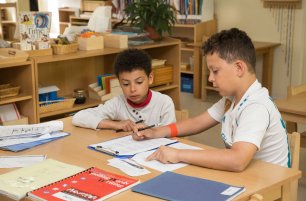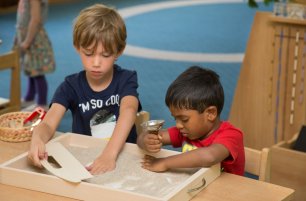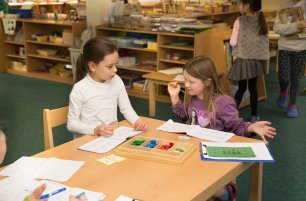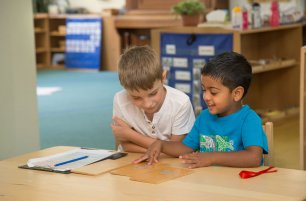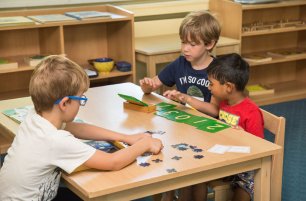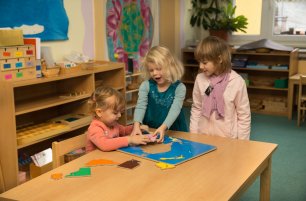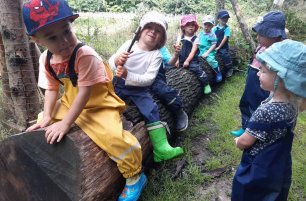Embracing the Multi-Age Group
It is no surprise to hear parents expressing doubts about a multi-age classroom, and questioning how children of different ages could work together harmoniously in the same environment, and if there are any benefits to this approach.
One of the many fundamental elements in Montessori’s method, developed after her long-term research in finding ways to better serve children’s needs, is her belief that multi-age children could benefit from each other in the same environment. Multi-age classrooms begin as early as 15 months in the Toddler classrooms, and subsequently joining Primary children in the Primary classroom from age 3 onwards. In our Primary classroom, we often address children aged 3-4 as Younger Friends, and children aged 5-6 as Kindergartners.
Benefiting a Younger Friend
One of the most valuable discoveries of Dr. Montessori was that observation is the cornerstone of the Montessori Method. Children absorb and learn the most simply by observing, and their period of observation begins as early as the Toddler environment. When toddlers begin their transition to a younger friend in the Primary classroom, they are usually in awe of what is happening around them, often perplexed by the older and bigger children working in the classroom. This is the stage that younger children try to identify with their peers, learning how to share the same communal space with the older children and the teachers, all through the power of observation.
A young child starts to observe an older child working, and throughout the process, not only do they grasp an idea of how to use a material in the classroom, or how to carry out a task, they also develop the urge to practice and achieve mastery with other related tasks.
Gaining practical skills
For instance, when a younger child observes an older child practicing how to wash a table, this same young child begins to unknowingly scrutinize an older child’s movement and pay attention to the isolated skills needed to wash a table, such as using an apron, transferring wet works, folding a cloth, and more. They are then inspired to practice these skills until achieving mastery, and when the day comes, they feel the readiness, they will want to learn how to wash a table.
Development of emotional skills
This does not stop at practical or even academic skills, since observing further improves their metacognitive, emotional and social skills. Younger children have the tendency to imitate the way interaction works between peers, and by observing an older child using grace and courtesy in the classroom by politely asking for help or resolving conflict, instinctively, they will try to assimilate and start imitating the exemplary behavior and start interacting in a respectful manner.

Benefiting a Kindergartner
After spending many years in the same classroom, the children are now familiar with the works of the classroom. In the first and second years, younger friends typically observe the dance of Kindergartners in the classroom, from their working habits to communication skills. When they turn five, the older children who so inspired them have moved up to Elementary, and they now transform into the new Kindergartners … this is the moment the metamorphosis happens and they take the plunge to discover their budding leadership skills.
Why children enjoy being Kindergartners
The kindergartners now enjoy being the new leaders and mentors in the classroom. They start practicing giving lessons to the younger members of the classroom, helping to clean up spilled work, and taking on duties and responsibilities in taking care of their classroom. This not only enhances their leadership skills but also helps build confidence in their self-worth, by phasing out unhealthy competition among each other. Multi-age groups benefit kindergartners in so many ways, as they learn how to share different skill sets with each other, and through communicating comfortably and confidently with others, they expand their abilities in the environment and create a huge diversity of value in our classroom community. Besides, they enjoy it so much, that they want to keep helping younger children!
Other benefits of multi-age classrooms
Different timelines of learning
In a multi-age classroom, children are at ease as they have the flexibility to work at their own pace. They do not feel the need to be competitive or frustrated if they cannot complete a task, as they typically do not feel like they are being left behind if they struggle with a concept. This is due to the combination of different children with different ages that ultimately lead to gaining different skill sets at different times. This also further contributes to the teachers in the environment being able to have in-depth knowledge on how to assist each individual child, having spent a great number of years observing and working with the children.
Fostering bonds and relationships
Multi-age groups also enhance and strengthen the bond and relationship that our teachers share with the children and their families. This gives us the best of opportunities to take our time to invest and learn more about their lifestyle at home and helps us tailor to the individualized needs of the children to set them up for success in everything they do. In the end, the children really are the ones who benefit MOST from multi-age classrooms, and that really is all that matters!
Take a look at why multi-age groups work
By Caryn Khoo, Primary Teacher Assistant
